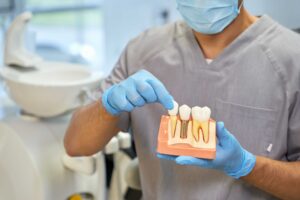In the realm of modern dentistry, dental implants have emerged as a revolutionary solution for restoring missing teeth. This comprehensive overview delves into the intricate science underpinning dental implants, from their components to the process of osseointegration, candidacy criteria, and the procedure itself.
Understanding Dental Implants
Dental implants are more than just prosthetic teeth – they’re an elegant replication of natural teeth. Comprising the implant, abutment, and crown, each component plays a crucial role. The implant, crafted from biocompatible titanium, is surgically embedded into the jawbone. The abutment acts as a bridge between the implant and the crown, which is visible and resembles a natural tooth.
The Science of Osseointegration
Central to successful dental implantation is osseointegration, where the implant becomes one with the jawbone. This process hinges on the exceptional properties of titanium, which encourages bone tissue to bond seamlessly over time. As the implant integrates, it becomes an integral part of your oral structure, ensuring stability and longevity.
Types of Dental Implants
Not all dental implants are created equal. Endosteal implants, the most common variety, are placed directly within the jawbone. Alternatively, subperiosteal implants sit below the gum but above the jawbone. The choice depends on various factors, including bone density and personal preferences.
Candidates for Dental Implants
Ideal candidates for dental implants possess adequate jawbone density, good oral health, and overall well-being. Those with insufficient bone volume may require bone grafting to bolster the chances of successful implantation. A thorough assessment by a qualified dentist is crucial to determine candidacy.
The Dental Implant Procedure
The dental implant procedure comprises several stages to ensure optimal results. It starts with a comprehensive oral assessment and a tailored treatment plan. The surgical phase involves strategically placing the implant in the jawbone. Over several months, osseointegration takes place, anchoring the implant securely. Once integration concludes, the abutment is attached, followed by the crown, meticulously restoring both aesthetics and function.
Advances in Dental Implant Technology
Recent technological strides have ushered in a new era of dental implantology. Advanced materials like zirconia offer strength and aesthetics in one package. The integration of 3D imaging and CAD/CAM technology enables precise planning, ensuring impeccable implant placement.
Benefits of Dental Implants
Dental implants bring a myriad of benefits, far surpassing traditional tooth replacement methods. Beyond enhanced chewing ability and speech, they prevent bone loss in the jaw, preserving facial structure and preventing the sunken appearance associated with missing teeth.
Potential Risks and Complications
While dental implant procedures are generally successful, potential risks include infection, implant failure, nerve damage, and sinus issues. Selecting appropriate patients, following post-operative instructions, and regular dental check-ups can significantly reduce these risks.
Aftercare and Maintenance
Safeguarding the longevity of dental implants necessitates diligent aftercare. Patients should uphold excellent oral hygiene practices, including regular brushing, flossing, and dental visits. Dentists might recommend specialized oral care products to maintain implant health.
Longevity of Dental Implants
With meticulous care, dental implants can endure a lifetime. However, individual factors like oral hygiene, lifestyle, and overall health influence their lifespan. Regular dental visits and proactive care are pivotal for ensuring implants’ lasting success.
Cost Considerations
The cost of dental implant procedures varies, contingent on factors such as the number of implants, implant type, and supplementary procedures. While the initial investment might be higher, the long-term advantages of dental implants often outweigh the costs.
Frequently Asked Questions (FAQs)
Are dental implants painful to insert?
Implant placement is typically carried out under local anesthesia, ensuring minimal discomfort during the procedure. Post-operatively, patients may experience mild pain, which can be managed with prescribed or over-the-counter pain relievers.
How long does osseointegration take?
Osseointegration duration varies but generally takes around three to six months. Factors such as patient health, bone quality, and implant type can influence the timeline.
Can smokers receive dental implants?
While smoking can impact healing and osseointegration, it’s not an outright contraindication. However, smokers should consider quitting or reducing smoking to enhance the chances of successful implantation.
Is the procedure covered by insurance?
Coverage varies depending on the insurance provider and plan. It’s advisable to contact your insurance company to understand your specific coverage for dental implant procedures.
Are there age restrictions for dental implants?
Age itself isn’t a determining factor. What matters is overall health and bone density. Patients of various ages can undergo dental implant procedures if they meet the necessary criteria.
How long does the crown last?
The longevity of the crown depends on factors like oral hygiene, chewing habits, and maintenance. With proper care, crowns can last a decade or more.
Can dental implants be rejected by the body?
Implant rejection, known as implant failure, is rare. With careful patient selection and proper implant care, the chances of rejection are significantly minimized.
Improve Your Oral Health With Hedgecock Dental
Hedgecock Dental is available for all of your family dentistry needs. Our dental office in Austin, TX provides general, sedation, restorative and cosmetic dentistry to patients of all ages.





